What Is Supported Independent Living (SIL)? Your Ultimate Guide
We answer commonly asked questions about Supported Independent Living to help you gain a clearer picture about what it is and how it works.
You are likely familiar with the term ‘Supported Independent Living’, or SIL for short.
It is part of the National Disability Insurance Scheme (NDIS) and is aimed at increasing independent living for people with disability.
But how does it work? What does it cover? And how do you get the funding?
There is a lot to learn when it comes to Supported Independent Living, so in this article we break it all down for you.
Here is your ultimate guide to SIL.

What Is Supported Independent Living?
Supported Independent Living (SIL) is a category of NDIS funding that supports people with disability to live in their home as independently as possible.
SIL funding is typically reserved for participants who require 24/7 support while living in a share home.
It exists to cover the cost of the support staff in the home, to help with daily tasks such as cooking meals or cleaning.
This funding is not intended to pay for rent or to cover other daily living expenses, like groceries.

What Kind of Supports Does SIL Include?
The table below gives a rundown of the key supports that SIL funding includes and those items that are exempt from SIL funding:


In What Household Settings Can SIL Funding Apply?
SIL funding can be used in the following settings:
- Shared or group accommodation
- Specialist Disability Accommodation (SDA)
- Private rental
- A house that you own
- Accommodation through the Department of Housing and similar services

What Is the Process for Receiving SIL Funding?
The SIL funding process differs to most other NDIS funding streams.
Typically, NDIS funding follows these steps:
- A participant receives an NDIS plan with dollar amounts assigned to the various categories
- The participant decides which service providers they wish to choose
- The participant signs on to receive supports
SIL funding works a bit differently:
- A participant gets funding for SIL in their NDIS plan, but it does not have an exact dollar amount assigned to it
- The participant works with their Support Coordinator and meets with relevant professionals, such as Occupational Therapists (OTs)
- These professionals determine the participant’s required level of support
- The participant works with their Support Coordinator to find a suitable home.

Where a participant is entering shared accommodation, the SIL provider prepares a quote for the whole home.
From there, the SIL provider creates a roster of care for the NDIS. This document identifies what a ‘typical week’ would look like for each individual within the home.
This is done to ensure those individuals receive the appropriate allocation and coordination of support staff to meet their needs.
While SIL funding is allocated individually, supports can be shared among all household occupants.
Although this process may sound confusing, there is good news. In the vast majority of cases, the SIL provider – like us at Endeavour Foundation – liaises with the National Disability Insurance Agency (NDIA) directly to finalise the process.

What Are the Levels of SIL Funding?
SIL funding is divided into three categories, depending on the level of support required and the number of people living in a shared setting. They are:
Lower need: Provides supervision of living arrangements and is not usually administered 24/7.
Standard need: Provides 24/7 support, including active assistance and/or supervision of most daily tasks and overnight sleepovers.
Complex need: Provides highly frequent assistance to the individual with:
- Managing challenging behaviours that require intensive support
- Continual active assistance with all daily tasks
- Active management of complex medical needs
- Active 24/7 support, including overnight
For full descriptions of these three categories, read the NDIS Pricing Arrangements and Price Limits.

Are SIL and SDA Funding the Same Thing?
No, they are not. There are several key differences between SIL and SDA.
In short, SIL funding applies to the necessary support services offered in the home while SDA funding relates to the actual brick-and-mortar accommodation in which those support services are delivered.

How Do I Get Started with SIL?
Talk to your Support Coordinator – they are an integral part of the SIL puzzle.
The NDIS pays Support Coordinators to help you work through the process and liaise directly with allied health and service providers.
It is extremely rare for a participant to receive approval for Supported Independent Living and not have Support Coordinator funding.

Your Trusted SIL Provider
As a leading SIL provider, we have one clear goal: to deliver outstanding service and supports that empower you to live your best life.
We do this by assisting you every step of the way, from navigating the NDIS and sign up to everyday living.
Our roster of friendly, experienced support workers is dedicated to delivering personalised, 24/7 support that enables you to live your best life.
Keen to have Endeavour Foundation in your corner? Reach out to us today to learn how we can help you to thrive.



